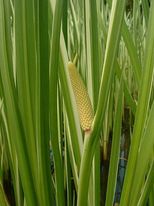- ACORUS CALAMUS
description & usage
A semi-aquatic perennial cultivated in damp marshy places in India and Burma. Exceedingly common in Manipur and the Naga Hills, and on the edges of lakes and streams. The underground stem or rhizome is succulent and yellow on the inside. The inflorescence is borne on the apical or terminal part of a long stalk.
Uses:
Cough, fever, capillary bronchitis, colic etc.,
How to Use:
The root burnt to cinder, mixed with cocoanut or castor oil and smeared over the abdomen relieves flatulent colic. The powder of the burnt root-stock in 3 grain doses relieves infantile diarrhoea and colic. It is used as a diuretic in calculous affections and as an anthelmintic to expel worms in children. The following is a valuable compound powder useful in dyspepsia and as a stimulaut in low fevers, epilepsy and insanity - Take equal parts of Acorus calamus root, Asafoetida, Ans, Long pepper, Black pepper, Ginger, Chebulic myrobalan and Sonchal salt. Powder and mix them well together. Dose - 20 to 60 grains.
Parts Used:
Rhizome
Taste:
Astringency
Action:
Digestive, emetic, aromatic, carminative, nervine sedative
Uses:
Cough, fever, capillary bronchitis, colic etc.,
How to Use:
The root burnt to cinder, mixed with cocoanut or castor oil and smeared over the abdomen relieves flatulent colic. The powder of the burnt root-stock in 3 grain doses relieves infantile diarrhoea and colic. It is used as a diuretic in calculous affections and as an anthelmintic to expel worms in children. The following is a valuable compound powder useful in dyspepsia and as a stimulaut in low fevers, epilepsy and insanity - Take equal parts of Acorus calamus root, Asafoetida, Ans, Long pepper, Black pepper, Ginger, Chebulic myrobalan and Sonchal salt. Powder and mix them well together. Dose - 20 to 60 grains.
Parts Used:
Rhizome
Taste:
Astringency
Action:
Digestive, emetic, aromatic, carminative, nervine sedative


